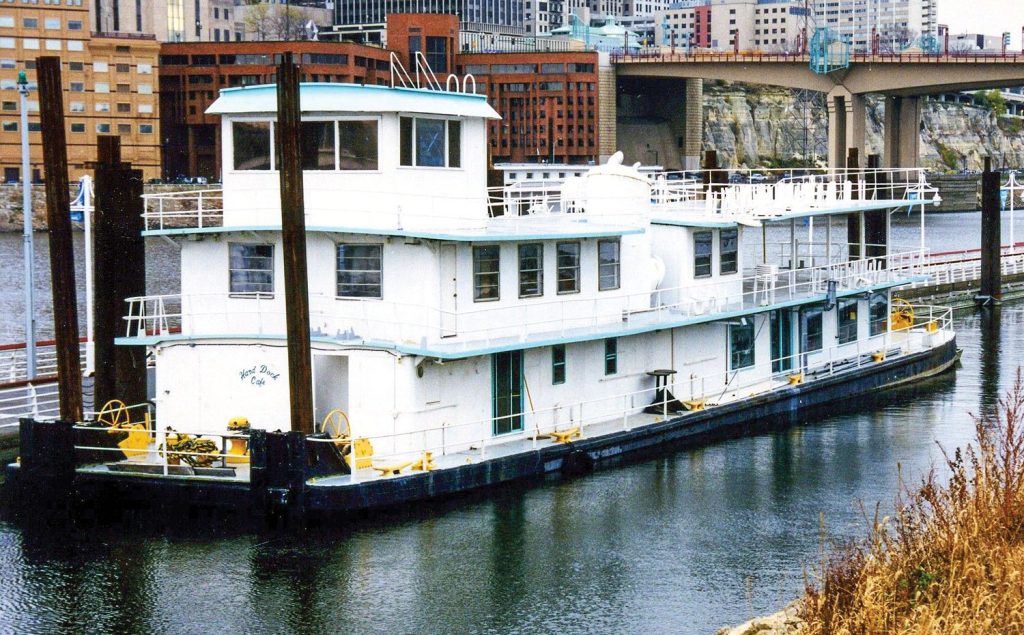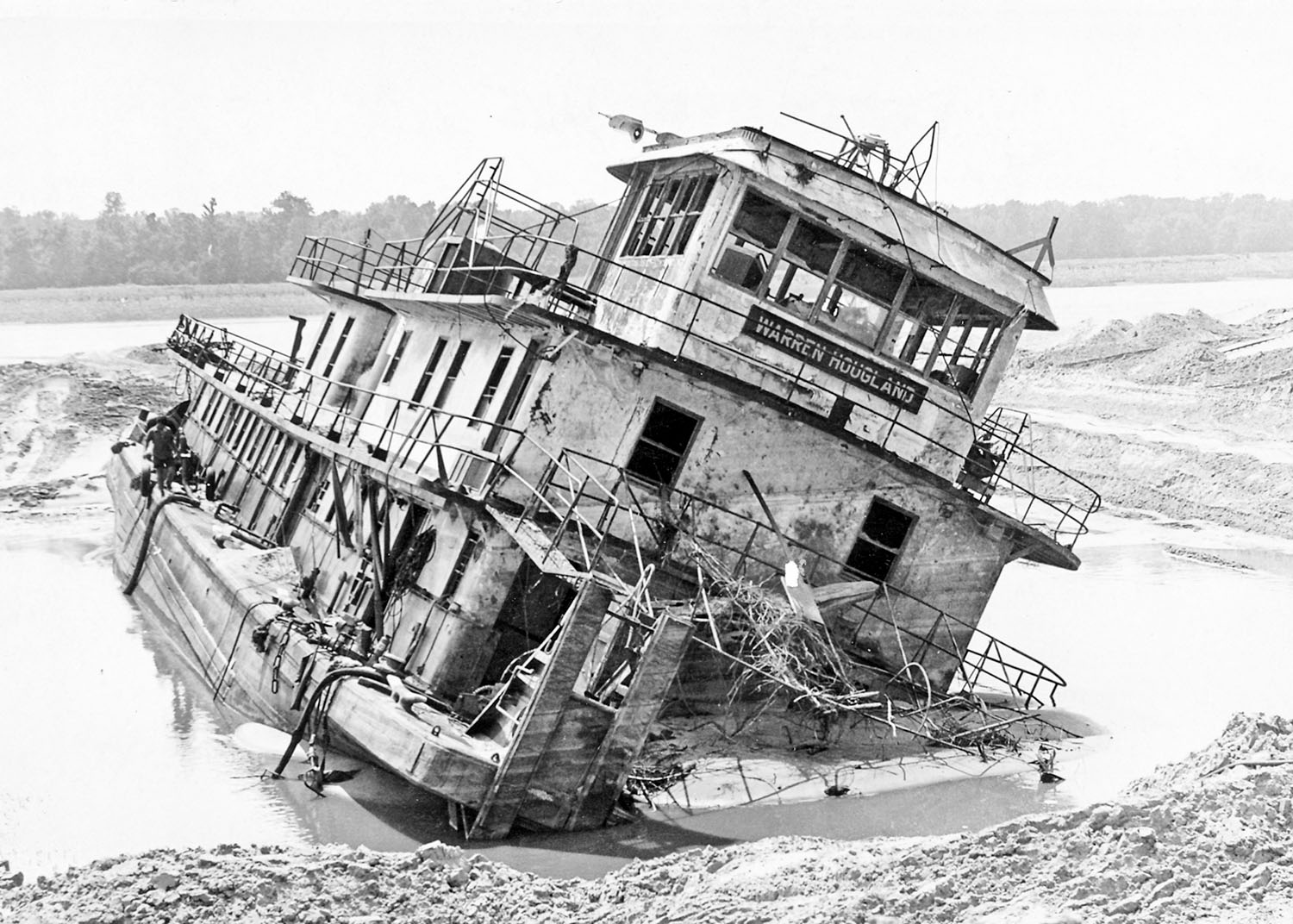In the last column we looked at the twin-screw towboat Dorothy H, built by Nashville Bridge in 1938 for Capt. Walter G. Hougland (later doing business as Walter G. Hougland Sons and Hougland Barge Line). The boat was 143 by 30 feet and had 1,100 hp. provided by two Nelseco diesels. This boat, large for the time, replaced two steam sternwheel towboats in the Hougland fleet.
Over time, the Dorothy H was rebuilt, with the superstructure modernized, and in 1949 it was renamed Warren Hougland. In 1951, it was repowered with GM 12-567A engines of 1,800 hp., and it was again re-engined in 1957 with GM 12-567C diesels of 2,400 hp.
The Hougland boats were familiar sights along the Mississippi River system. Most had been built by Nashville and closely resembled each other with white cabins trimmed in black and a large gray stripe along the bottom of the main cabin bulkhead extending from handrail to deck. These boats usually carried a spare rudder and two spare propellers aboard.
People who worked aboard the Hougland boats, including longtime correspondent Capt. Jeff Yates of The Waterways Journal, have remarked about the preponderance of brass fixtures aboard the Nashville-built boats: doorknobs, hinges and sill plates, interior handrails, stair treads, steering levers and window latches—just to name some of the items—all of which had to be polished.
For the Warren Hougland, disaster struck on March 13, 1973. In the pre-dawn hours, the boat was upbound on the Lower Mississippi River with a four-barge tow on a river that was rising some 1-1/2 feet per day. Just below Togo, at Mile 413, it had to hold for downbound traffic. In the maneuver to hold the tow, the stern of the boat came in contact with a revetment, and a rudder was apparently forced through the hull.
A story in the March 24, 1973, issue of The Waterways Journal said that the four loads in tow broke loose and were “corralled by the Kate Tully.” The pilot aboard the Warren Hougland managed to beach the boat on a sandbar below the Togo Island Dikes near Mile 412.3 to prevent it from sinking.
Salvage operations commenced nearly immediately; however, the situation with the rising river was compounded when a storm system came through the area and up into the Ohio River Valley over March 15-16. The Lower Miss stage at Vicksburg had read 31.2 on March 13, and continued to rise for two months. By March 22, the 35-year-old, widely traveled Warren Hougland was completely covered by water. The crest of 53.1 feet came on May 13 and was stationary for several days before beginning a slow fall. When the water went down, only the top of the pilothouse and parts of the stacks on the Hougland were visible above the sand.
A feature story in the September 8, 1973, issue of the WJ detailed “one of the most unusual salvage projects ever undertaken on the inland waterways.” A Vicksburg man named Bernie Bierman, described as a “contractor, builder and promoter,” had purchased the buried vessel from the insurance company in the belief that it could be successfully dug out and refloated. Bierman moved equipment such as a bulldozer, dragline and pumps to the site and began the task of “digging and washing the sand from around the boat.” The story also stated that Bierman intended to refurbish the boat and was in the process of forming a company to be called Triple B Lines Inc. to operate it. The story said that it was to be renamed Margie P. Bierman, after his wife.
The December 22, 1973, issue of the WJ reported that the Warren Hougland had been successfully refloated and moved up to Vicksburg to begin the refurbishing. Plans now included repowering the boat to 3,600 hp. In the end, these plans never came to fruition. A timeline for the vessel was compiled by the late Dan Owen, an editor of The Waterways Journal as well as editor and voracious fact finder for the Inland River Record for many years, and it was graciously shared by Capt. Mike Herschler. Yates (who decked on the boat in the 1960s) added his recollections, and the following is the later history of the boat.
Following the resurrection of the Warren Hougland out of the sand, it lay in the Vicksburg area for some time. By July 1974, it was at Harvey, La., and it was being stripped, supposedly for rebuilding. In 1980, it was at Baton Rouge, La., serving as an office and landing boat for Bisso Towboat Company. In 1995, it was at Belle Chasse, La.; in September of that year, it was towed to the St. Paul area by the Peter Fanchi, then of Midland Enterprises. In early 1996, it was spotted pulled out of the water at the Dakota Barge Service facility at St. Paul. New windows were being installed, and superstructure alterations were being done. In October 2000, it was a floating establishment at St. Paul called the “Hard Dock Café.” In 2010, it was seen with a sign reading “River Boat Grill.”

If anyone in the St. Paul area can update us on the status of this storied craft, please let us know!
Capt. David Smith can be contacted at davidsmith1955obc@gmail.com.
Caption for top photo: The Warren Hougland at Mile 412.3 Lower Mississippi River, August 23, 1973, emerging from the sand during salvage. (Dan Owen Boat Photo Museum collection)




